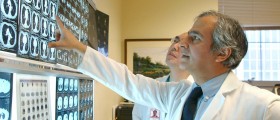
Overview of Ultrasound
Ultrasound is a type of image scanning during which an organ is exposed to high frequency sound waves. Unlike X-Rays, ultrasound does not emit radiation so the person is not subjected to any adverse effects. The principles of ultrasound are similar to those of a submarine. The sound waves are emitted through a tube called transducer into the organ in question where they produce an echo. Based on this echo the individual performing the test can determine the shape and size of the organ as well as the presence of any masses of cells or tumors. Also, ultrasound provides live streaming from inside the body and can also be used to follow substances injected into a person as they travel through the blood stream. The technique used for this purpose is called the Doppler effect. Utilizing the Doppler effect, ultrasound exams are able to reveal the conditions of veins, arteries, and blood vessels. Most ultrasound tests are non invasive and therefore painless. However, transvaginal and transrectal tests involve penetration and are often used for extracting small tissue samples for pathological testing. The most common type of ultrasound is the abdominal test that includes organs such as bladder, kidneys, abdominal aorta, gallbladder, spleen, and pancreas. Other types of exams include the pelvic and thyroid ultrasound. Ultrasounds are performed by trained technicians or by specialists called radiologists. The results are either interpreted on the spot or are sent to the primary health care provider or to the referring doctor.Importance of Thyroid Ultrasound
The thyroid gland is located just above the collarbone with one part being on either side of the neck. Thyroid gland is one of the 9 endocrine glands in the body responsible for releasing hormones into the blood. One of the many functions of the thyroid hormone includes regulating heartbeat. The ultrasound of the thyroid generates images of the gland and the nearby structures. Different types of problems can be detected using ultrasound including identifying lumps that cannot be felt during a physical exam. In most cases the lumps do not pose any threat to health, but there are instances in which they can grow from benign lesions into malignant tumors. By using ultrasound doctors can determine whether the lump in question is coming directly from the thyroid gland or from one of the nearby structures. If a doctor feels a lump during a physical exam he or she is likely to send the patient to get an ultrasound in order to detect any other changes. Ultrasound is often used to screen for unusual growth of the thyroid gland. As previously mentioned, ultrasound provides real-time images so it is often used for guidance during biopsies or procedures in which the needles are used to extract cells from an organ.How To Prepare For Thyroid Ultrasound?
It is recommended that patients wear comfortable clothing and leave the jewelry at home. Most of the clothing will probably be removed and a disposable paper robe will be put on. The patient is asked to lie on a table face up but in many instances he or she will have to change positions to get a better view. There will probably be a pillow provided to extend the area that needs to be scanned. If the patient is suffering from neck pain the technician needs to be informed so the most comfortable position is found. Holding the breath can also be expected as it provides the images when there is no movement in the body. Such images are sometimes more accurate, especially if the radiologist is looking for a blockage. Parents are advised to talk to their children before the test so that everything goes smoothly. Ultrasound is very sensitive to motion so it is crucial to lie still. When it comes to the machinery, ultrasound is composed of a transducer, computer, video screen, and electronics. The transducer is a tube that is used to emit the sound waves. Prior to the exam, the technician will put a clear gel on the area that will be inspected to facilitate the process. The images are available on the screen immediately and the person performing the test will probably discuss the finding with the patient. The formal report will be sent to the referring physician within a few days. The exam should not last more than half an hour. Upon completion the patient can resume normal daily activities right away. In many cases more that one ultrasound is needed to obtain the most accurate results. If there are changes on the organ in question they may need to be clarified but in any case the referring physician will explain to the patient the reason for follow up tests. Another common reason for repeated ultrasounds is to monitor reactions to therapy and to see the outcome of treatment.
















Your thoughts on this
Loading...